The 2020 Mac Mini Unleashed: Putting Apple Silicon M1 To The Test
by Andrei Frumusanu on November 17, 2020 9:00 AM ESTBenchmarks: Whatever Is Available
As we’ve had very little time with the Mac mini, and the fact that this not only is a macOS system, but a new Arm64-based macOS system, our usual benchmark choices that we tend to use aren’t really available to us. We’ve made due with a assortment of available tests at the time of the launch to give us a rough idea of the performance:

One particular benchmark that sees the first light of day on macOS as well as Apple Silicon is Cinebench. In this first-time view of the popular Cinema4D based benchmark, we see the Apple M1 toe-to-toe with the best-performing x86 CPUs on the market, vastly outperforming past Apple iterations of Intel silicon. The M1 here loses out to Zen3 and Tiger Lake CPUs, which still seem to have an advantage, although we’re not sure of the microarchitectural characteristics of the new benchmark.
What’s notable is the performance of the Rosetta2 run of the benchmark when in x86 mode, which is not only able to keep up with past Mac iterations but still also beat them.
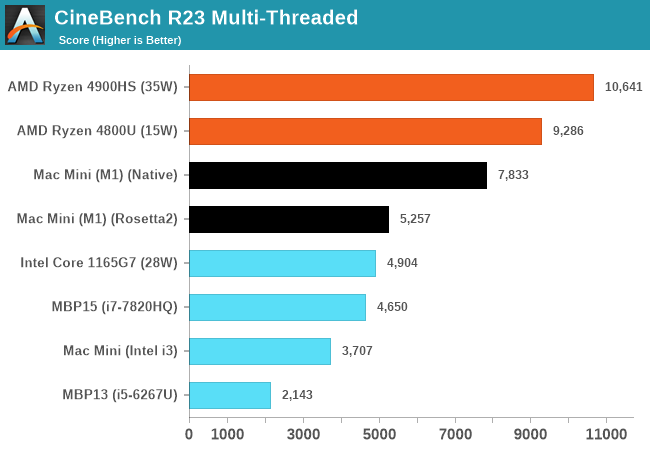
In the multi-threaded R23 runs, the M1 absolutely dominates past Macs with similar low-power CPUs. Just as of note, we’re trying to gather more data on other systems as we have access to them, and expand the graph in further updates of the article past publishing.
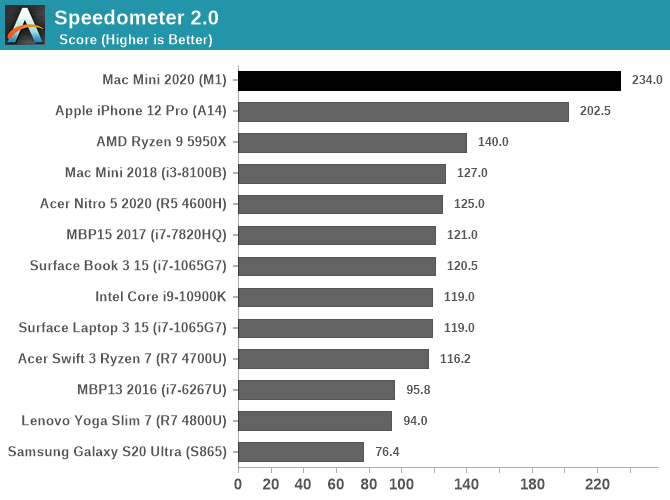
In browser-benchmarks we’ve known Apple’s CPUs to very much dominate across the landscape, but there were doubts as to whether this was due to the CPUs themselves in the iPhone or rather just the browsers and browser engines. Now running on macOS and desktop Safari, being able to compare data to other Intel Mac systems, we can come to the conclusion that the performance advantage is due to Apple’s CPU designs.
Web-browsing performance seems to be an extremely high priority for Apple’s CPU, and this makes sense as it’s the killer workload for mobile SoCs and the workload that one uses the most in everyday life.
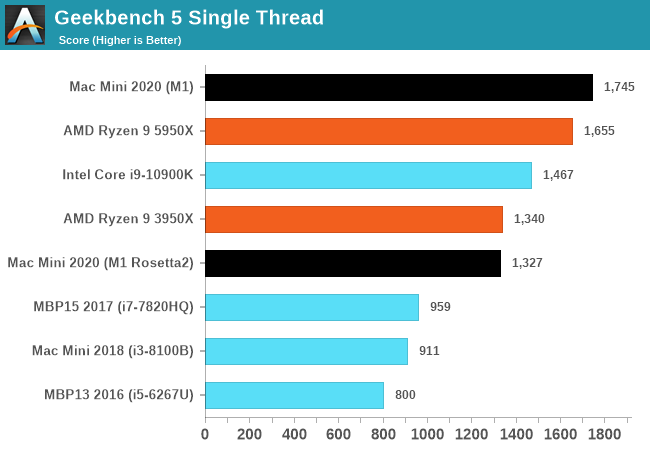
In Geekbench 5, the M1 does again extremely well as it actually takes the lead in our performance figures. Even when running in x86 compatibility mode, the M1 is able to match the top single-threaded performance of last generation’s high-end CPUs, and vastly exceed that of past iterations of the Mac mini and past Macbooks.
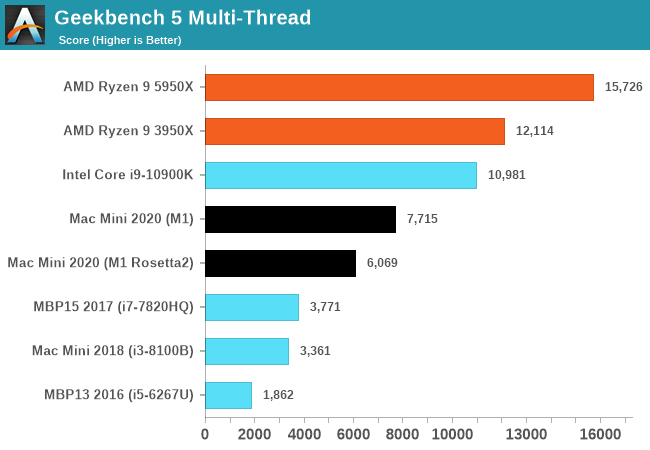
Multi-threaded performance is a matter of core-count and power efficiency of a design. The M1 here demolishes a 2017 15-inch Macbook Pro with an Intel i7-7820HQ with 4 cores and 8 threads, posting over double the score. We’ll be adding more data-points as we collect them.


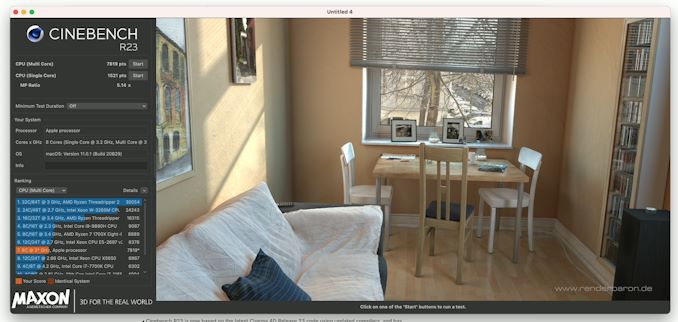








682 Comments
View All Comments
Makste - Wednesday, November 18, 2020 - link
I'm still impressed by this M1 chip. Goes to show what ditching the L3 cache for a larger L2 cache can do for performance uplift (not that its the only reason for M1's performance). X86 fellow fans should accept this challenge for the greater good of technological advances, especially when considering the intergrated M1 graphics and a fan free system. AMD should be able to come up with an equal or better option since it deals in both gpu and cpu technology. What it requires is reasonable funding.ricebunny - Wednesday, November 18, 2020 - link
Why is the Intel i7 1185G7 (28W) over 20% slower in ST SPECfp 2017 in this review, compared to your review from 2 months ago?The score from the original review was: 6.42,10.75 for int,fp respectively. In this review it scores 6.17,8.60. That would make it marginally faster than m1 in fp and marginally slower in int.
Link: https://www.anandtech.com/show/16084/intel-tiger-l...
ChrisGX - Thursday, November 19, 2020 - link
Yep, that is a discrepancy that needs to be explained. I say that as reader with great admiration for Andrei Frumusanu, not an Intel fanboy.The Hardcard - Thursday, November 19, 2020 - link
It is explained in the article. He doesn’t have a FORTAN compiler for the Apple hardware, so the composite numbers for this article excludes those tests.trboyden - Thursday, November 19, 2020 - link
Because as usual in biased reporting, if it goes against the agenda you have for an article, you skew the numbers and hope not to get caught. Similar to why they didn't compare to the i9 mobile processor that has 8-cores like the M1, and instead compared to an i7 that only has 4-cores. The i9 would toast the M1, but that goes against the author's agenda for the article.ChrisGX - Thursday, November 19, 2020 - link
We need some discrepancies explained not a tale of woe infected by a fanboy nightmare.Spunjji - Thursday, November 19, 2020 - link
👍👍👍Spunjji - Thursday, November 19, 2020 - link
Alternatively, as noted in the article, they couldn't run the whole SPEC 2017 suit yet due to the current lack of an appropriate Fortran compiler.KPOM - Friday, November 20, 2020 - link
For starters, 4 of the cores run at 1/10 the power of the other 4 and are intended for lower-demanding tasks. That said, Apple said that those 4 cores have the same overall power as the dual-core MacBook Air from earlier in 2020.Spunjji - Thursday, November 19, 2020 - link
I'm pretty sure it's because of this:"It’s to be noted that currently we do not have a functional Fortran compiler on Apple Silicon macOS systems, thus we have to skip several workloads in the 2017 suite, which is why they’re missing from the graphs. We’re concentrating on the remaining C/C++ workloads."
Hard to know exactly what effect that would have on the overall rankings. Good spot, though!